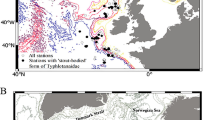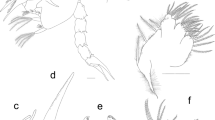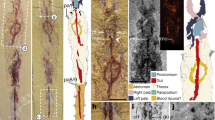Abstract
Gromia oviformis Dujardin, 1835, and Allogromia ovoidea Rhumbler, 1903, are marine rhizopods with which the general zoologist is usually acquainted. The former is well known because of its abundance in the inter-tidal zones around the rocky parts of the British coasts, and reference has been made to it in some text-books of invertebrate zoology and proto-zoology. Allogromia ovoidea, although less well known, as a living animal, has been prominently figured on many occasions in standard zoological text-books. During the past fifty years a great deal of confusion has arisen concerning these two protozoans, as a result of which incorrect names are now given in several text-books and standard works of reference.
This is a preview of subscription content, access via your institution
Access options
Subscribe to this journal
Receive 51 print issues and online access
$199.00 per year
only $3.90 per issue
Buy this article
- Purchase on Springer Link
- Instant access to full article PDF
Prices may be subject to local taxes which are calculated during checkout
Similar content being viewed by others
References
Schultze, M. S., “Über den Organismus der Polythalamien (Foraminiferen)” (Englemann, Leipzig, 1854).
Lankester, E. Ray, “A Treatise on Zoology”, Part 1, “Introduction and Protozoa” (Adam and Charles Black, London, 1903).
Doflein, F., “Lehrbuch der Protozoenkunde”, Aufl. 2 (Gustav Fischer, Jena, 1909).
Minchin, E. A., “An Introduction to the Study of the Protozoa” (Edward Arnold, London, 1922).
Calkins, G. N., “The Biology of the Protozoa”, 1st edit. (Baillière, Tindall and Cox, London, 1926.
Calkins, G. N., “The Biology of the Protozoa”, 2nd edit. (Baillière, Tindall and Cox, London, 1933).
De Saedeleer, H., Mém. Mus. Hist. Nat. Belg., Mem. No. 60 (1934).
Borradaile, L. A., Eastham, L. E. S., Potts, F. A., and Saunders, J. T., “The Invertebrata” 1st edit. (University Press, Cambridge, 1932).
Borradaile, L. A., Eastham, L. E. S., Potts, F. A., and Saunders, J. T., “The Invertebrata” 2nd edit. (University Press, Cambridge, 1935).
Borradaile, L. A., Eastham, L. E. S., Potts, F. A., and Saunders, J. T., “The Invertebrata” 3rd edit. (University Press, Cambridge, 1958).
Marine Biological Association, “Plymouth Marine Fauna” (1957).
Dujardin, F., Ann. Sci. Nat. Zool. (2), 4, 343 (1835).
Rhumbler, L., Arch. Protistenk., 3, 181 (1903).
Schenk, E. T., and McMasters, J. H., “Procedure in Taxonomy”, 3rd edit. (Stanford University Press, California, 1956).
Jepps, M. W., Quart. J. Micr. Sci., 70, 701 (1926).
Arnold, Z. M., Univ. Calif. Publ. Zool., 61, (1955).
Author information
Authors and Affiliations
Rights and permissions
About this article
Cite this article
HEDLEY, R. Confusion between Gromia oviformis and Allogromia ovoidea. Nature 182, 1391–1392 (1958). https://doi.org/10.1038/1821391a0
Issue Date:
DOI: https://doi.org/10.1038/1821391a0
This article is cited by
-
New species of Gromia (Protista, Rhizaria) from South Georgia and the Falkland Islands
Polar Biology (2022)
-
Three new species of Gromia (Protista, Rhizaria) from western Greenland fjords
Polar Biology (2021)
-
High diversity of deep-sea Gromia from the Arabian Sea revealed by small subunit rDNA sequence analysis
Marine Biology (2006)
Comments
By submitting a comment you agree to abide by our Terms and Community Guidelines. If you find something abusive or that does not comply with our terms or guidelines please flag it as inappropriate.



